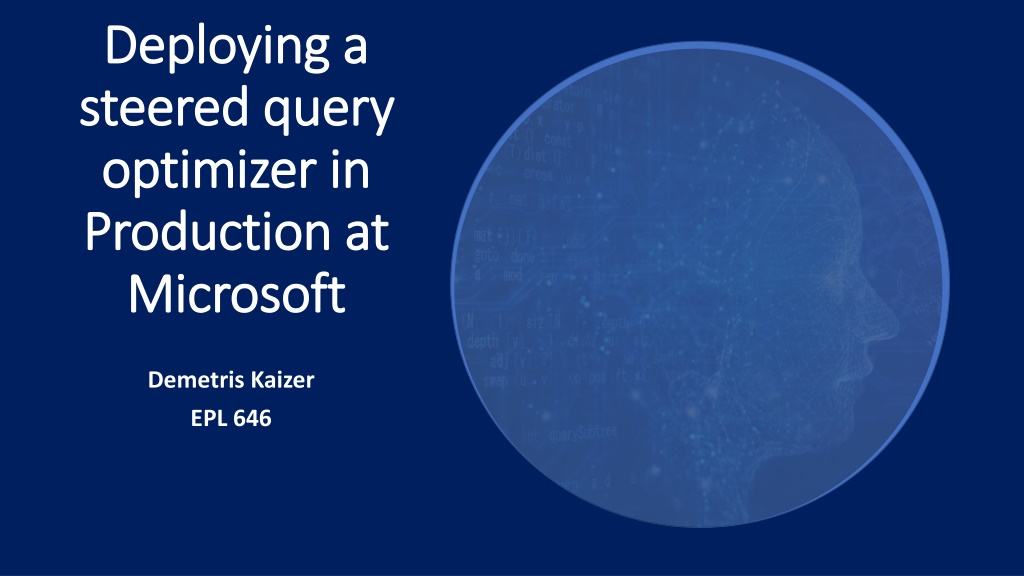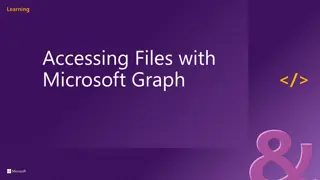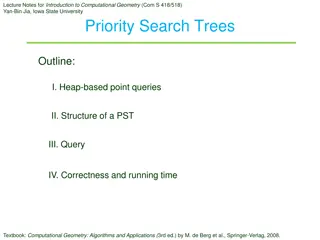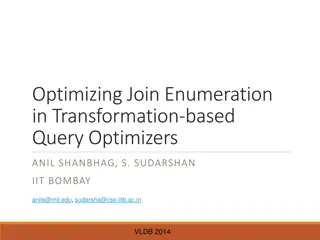Enhancing Query Optimization in Production: A Microsoft Journey
Explore Microsoft's innovative approach to query optimization in production environments, addressing challenges with general-purpose optimization and introducing specialized cloud-based optimizers. Learn about the implementation details, experiments conducted, and the solution proposed. Discover how rule hints and machine learning are leveraged to steer the optimizer towards better query plans, leading to cost-effective and explainable optimization strategies.
Download Presentation

Please find below an Image/Link to download the presentation.
The content on the website is provided AS IS for your information and personal use only. It may not be sold, licensed, or shared on other websites without obtaining consent from the author. Download presentation by click this link. If you encounter any issues during the download, it is possible that the publisher has removed the file from their server.
E N D
Presentation Transcript
Deploying a Deploying a steered query steered query optimizer in optimizer in Production at Production at Microsoft Microsoft Demetris Kaizer EPL 646
Roadmap 1. 2. 3. 4. 5. Introduction Background Implementation Details Experiments Conclusion
Introduction Introduction
Introduction Introduction The PROBLEM: General purpose query optimization is not working. Why? Generic benchmarking doesn t represent real customer workloads Are build for all users/scenarios
Introduction There is a need for specialize cloud-based query optimizers.
Introduction Introduction Recent work proposed Machine Learning Neo Proposed to replace the entire query optimizer with a learned one Not possible in real systems This paper proposes to use these ideas to production. BAO Proposed to steer the optimizer towards better plans Using rule hints to navigate the search space
Introduction Introduction - Previous approaches used many rule hints to steer the optimizer. This hard to explain/understand what helped. - Experimentation costs are huge. Large systems hard to sample. - Unseen search space can lead to performance regression because estimated cost is not accurate THE Problems!
THE MAIN IDEA! break the steering into small explainable steps THE Solution! Q0-Advisor Cost effective Explainable Safe
Background Background
Terminology Terminology Flighting A/B Test Infastracture to run job Token The number of concurrent containers used by each job Vertices The total amount of tokens used to execute a job. PNhours The sum of the total CPU and I/O over all vertices
Background A large, distributed processing system Petabytes of data processing SQL like scripting language Scope scripts are refered as jobs SCOPE: More than 60% of scope jobs are recuring Scope We can use historic data Characteristics
Background Scope Rule-based optimizer: Rule Signature: Job Span: 256 Rules, 4 Categories (implement rules, required, off-by- default, on-by- default) A bit vector representation of which rules directly contributes A set containing rules that when enabled / disabled can affect the query plan.
Background Q0-Advisor Recommends better search paths via rule hints Leverage post telemetry to explore better query plans Offline Pipeline Design Principles of Q0-Advisor Single rule flip Trained contextual bandit from historical data Learn rule configuration from the estimated cost of the scope optimizer Avoids regression by flighting a small number of jobs
Q0 Pipeline Overview Validation Recommendation Leverages the concept of Rule Signature (B) and Job Span (S). There are 2^B possible actions very large Uses Estimates Costs and Flighting to avoid regressions Decides whether to accept or reject the plan But better use S that can affect the plan Limiting the search space to a single bit deviations -> 1 + S possible actions (S typically is 10)
Implementation Details Implementation Details
Learning Principles Introduction to Contextual Bandit Extension of supervised learning For problems where enumeration is impractical Evaluates only actions made by the learning algorithm
Feature Generation The span algorithm implements an heuristics search whereby only new rules having effect on the final plan can be discovered. Job Span generation Each job executes a script which can contain one or more queries. Feature Aggregation PN hours, latency, total containers used Example Features:
Experiments Experiments
Job PN Delta - - PNhours improvements 50% - best case PNhours regression 15% - worst case
Job Latency Delta - - Improve latency by 90% - best case. Regression by 45% - worst case.
Job Vertices Delta - Regression of 10% in the worst case. - Improves vertices utilization by more than 60%.
Lessons Learned Research to practice trade-offs Simplicity first Generating new rules configurations requires large resources Arbitrary complex rule configurations difficult to debug
Conclussions QO-Advisor introduced Improved query optimization in SCOPE Runs offline daily and deployed across production SCOPE clusters























